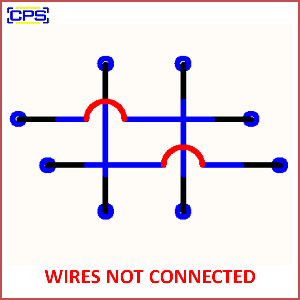Wires Not Connected refers to a situation where electrical wires are not linked or joined in a circuit, preventing the flow of electrical current or signals. When wires are not properly connected, the circuit remains open, and the electrical components within the circuit cannot function as intended.

Key Features of Wires Not Connected:
- Open Circuit:
- When wires are not connected, the circuit is considered open, meaning there is no continuous path for current to flow. This results in the malfunction of any electrical devices or systems relying on that circuit.
- No Power Flow:
- Without proper connections, electricity cannot flow between components, meaning devices such as lights, motors, or other electronics will not work.
- Signal Interruption:
- In circuits where signals are transmitted (such as in communication systems or data transfer applications), disconnected wires can interrupt or prevent the flow of signals, causing errors or loss of communication.
Causes of Wires Not Connected:
- Physical Disconnection:
- Wires may become physically disconnected due to loose connections, damaged terminals, or faulty solder joints in the circuit.
- Unplugged or Detached Wires:
- In systems that rely on plug-in connections or removable components, wires may become unintentionally disconnected, leading to a loss of power or signal.
- Improper Wiring:
- If wires are not connected during the initial setup or installation, the electrical circuit may not function at all.
- Circuit Design Error:
- In some cases, wires may be intentionally left unconnected in a design as part of a process for testing, maintenance, or future integration.
Effects of Wires Not Connected:
- Non-Functioning Devices:
- Any device or component within the circuit that relies on the flow of electricity will fail to operate when wires are not connected. For example, a disconnected wire in a lighting system will prevent the light from turning on.
- Inconsistent or Missing Signals:
- If signal wires are disconnected in a communication or data transfer system, the transmission of signals will be interrupted, leading to errors, data loss, or complete failure of the system.
- Safety Hazards (in some cases):
- While disconnected wires typically do not cause immediate danger, exposed, loose wires in certain conditions may pose a risk of electric shock or fire if they make an unintended connection with another conductive surface.
Applications and Considerations of Wires Not Connected:
- Testing and Maintenance:
- Wires are sometimes left disconnected for testing or troubleshooting purposes. This is done to isolate faults in a circuit or to perform repairs.
- Temporary Setup:
- During the setup or modification of electrical systems, wires may be temporarily left disconnected until final installation or configuration is completed.
- Prevention of Power Flow (Safety Purpose):
- Wires may be disconnected intentionally in order to isolate dangerous or faulty components for safety reasons. This helps prevent the system from running in an unsafe condition.
